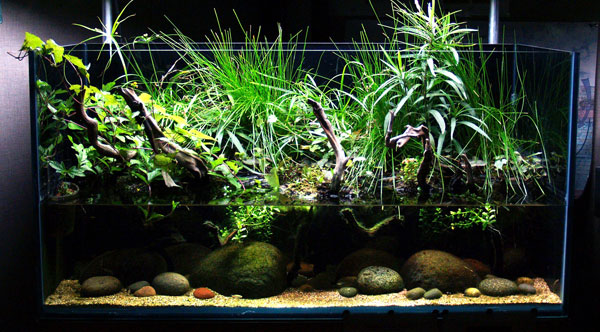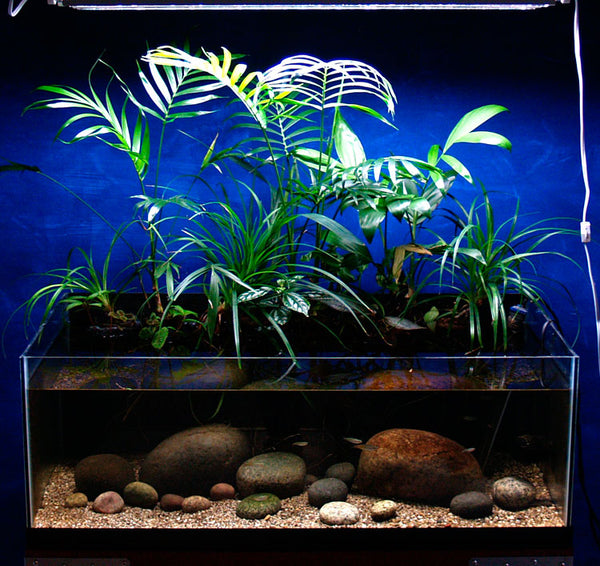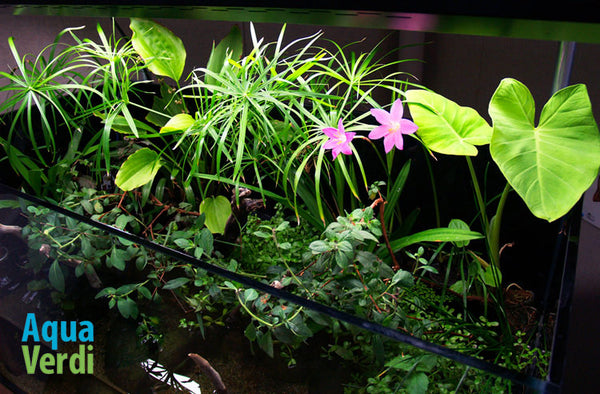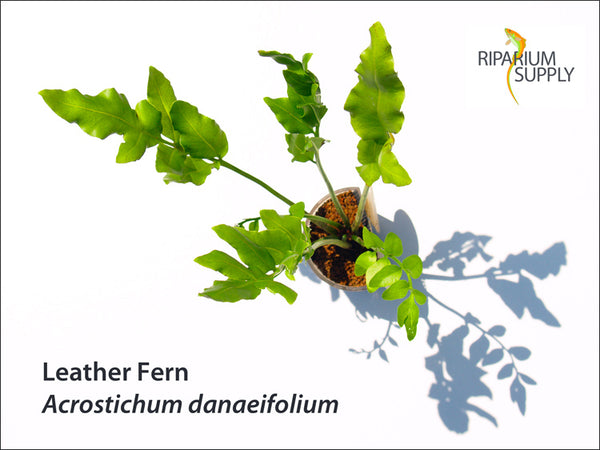News / Aqua Verdi
Part 1: Three Riparium Biotope Ideas
This short series of posts will offer suggestions for planning and establishing biotope ripariums to represent the aquatic habitats of three different regions. Aquarium biotopes create the most natural-looking combinations of plants, substrates and livestock, while also providing excellent opportunities to learn about the flora, fauna and ecology of beautiful wild places. We should all build more of them!
Part 1: Southern United States, Mexico & Central America

The Biotope: the freshwater aquatic habitats in this vast area are represented by a wide variety of distinctive ecosystems that include swamps, rivers, lakes and mountain streams, but there is a certain amount of overlap in the aquatic plant and fish diversity. While planning a riparium biotope for specific kinds of fish, the aquarist should focus on a specific area and habitat to guide plant, hardscape and substrate choices.
Hardscape & Substrate: try to find photos or scientific descriptions for the specific area you wish to represent. There is wide variety. Mountain streams in the Southern United States, Mexico and Central America are typically lined with large rounded boulders and finer gravel particles. Swamps, marshes and quiet creeks can be recreated in the aquarium with gentle water flow and finer gravel substrate combined with sunken manzanita twigs and oak or magnolia leaves. Lakes often have more angular boulders and beds of sand or fine gravel. A large sunken driftwood stump can also help to recreate a lake environment.
Livestock: the most popular aquarium fish from this region are livebearers in Family Poecilidae and various cichlids (Family Cichlidae). Among fish from the Southeastern United States, an area with exceptionally high fish biodiversity, are a few other groups kept in aquariums, such as cyprinids and darters. Very small livebearers, such as Heterandria formosa, can be housed in nano tanks of just a few gallons, while large Central American cichlids or groups of Poecilia sailfin mollies might require aquariums of 75 gallons or larger. There are also many fish species options from this area to inhabit medium-size tanks, such as wild type Xiphophorus platies & swordtails and Cryptoheros cichlids. The Mexico-endemic livebearer family, Goodeidae, also includes fascinating and beautiful aquarium choices.
Riparium plants: fortunately, a number of the best, well-tested riparium plant choices originate from this area. The following lists several of these with notes:
- Asclepias curassavica "Mexican Milkweed" - this tropical relative of the familiar monarch butterfly food plant grows in wet, sunny places throughout the Southern United States, Mexico and Central America. It is one of the easiest riparium plants to grow and bloom. Combine it with grassy riparium plants, such as Cyperus, to create a riverbank or marsh environment.
- Cyperus spp. dwarf "Umbrella Sedge" - there are three or four different small-growing Cyperus species available for sale in the gardening trade. While they may not necessarily be from this area, there are dozens of native species of Cyperus from wet habitats in this area that share the characteristic tall stalk with a a whorl of grassy leaves on top, so the common garden varieties will work well as riparium stand-ins.
- Echinodorus cordifolius - another species that occurs throughout this area, this is also the Echinodorus swordplant that adapts best as an emersed plant in riparium conditions. The all-green species plant grows to a large size relatively fast, so it is a good choice for filling out a larger planting, while the white-variegated cultivar E. cordifolius 'Tropica Marble Queen', stays shorter.
- Ruellia brittoniana "Mexican Petunia" - another widespread plant in this area, R. brittoniana is available as several different cultivars that vary in stature and flower color. The dwarf forms of Ruellia brittoniana have foliage that reaches out across the water horizontally and are especially useful for adding visual depth and hiding riparium planters. Provided with good light and fertilization, Mexican petunias will flower abundantly in the riparium with white, blue, pink or violet blossoms.
- Spathiphyllum spp. "Peace Lily" - this familiar houseplant originates from the tropical species that grow along rainforest swamps and streams in Southern Mexico and Central America, as well as South America. Use it with the above species and others to create a biotope for poecilids and cichlids from these more tropical areas.
-
Zephyranthes spp. "Rain Lily" - this true lily grows from a bulb and blooms with beautiful white, yellow or pink flowers. It is very easy to grow, but the the flimsy, onion-like leaves provide little foliage, so it should be combined with other more robust plants in the riparium layout.
With some research, a dedicated hobbyists can find other possibilities among hardscape, livestock and riparium plants choices to recreate aquatic biotopes for this region. Some of the plants mentioned in the list above are actually represented by numerous different species in the Southern US, Mexico and Central America that might be difficult to find, but the species available as garden plants, including the Riparium Supply selections in our online store, can work well as stand-in representatives.
Thank you for reading! Stay tuned and watch for our next two articles to offer more ideas for planted riparium biotopes.



No extra CO2 Required!...And Other Reasons for a Planted Riparium as Your Next Aquascape.
We are quickly approaching the long, grey, cold winter months and the best time of year for new aquascaping projects. As you start planning your new layouts, consider trying a planted riparium.

Above, riparium layout in a 40-gallon tank.
Ripariums are a special kind of planted tank featuring marginal aquatic plants; species adapted to grow their roots in very wet soil or in the mud under shallow water, but with most of their foliage in the air. Some very popular aquarium selections, such as Cryptocoryne, Echinodorus, Anubias and many stem plants can grow as marginals with emersed-adapted foliage growing above water, although for aquariums these are usually grown in their immersed (underwater) forms.
Ripariums are further distinguished from another special kind of planted model ecosystem, the paludarium. While they look superficially similar, paludariums use a built-up hardscape to support the planting, whereas ripariums use planter cups positioned on the aquarium glass. Furthermore, the paludarium hardscape is intended to function as part of the visual design, while the riparium planters are hidden from view as the plants grow in.
The following lists the most appealing features of planted ripariums as living displays:
- No extra CO2 required - carbon dioxide gas, essential for plant growth, is many times more available in the air than underwater. Plants in traditional aquascapes are usually limited more be the availability of CO2 than any other factor, so serious aquascapers install CO2 injection systems with pressurized tanks, regulators and diffusers. While CO2 systems can be fun to set up and run, they also represent extra expense and maintenance demands. Riparium plants easily get all of the carbon dioxide they need from the air, so they do not need extra CO2 for vigorous growth.
- Biotope representation - some of the most beautiful wild aquatic ecosystems have few fully submerged underwater plants. Among these are blackwater swamps, mangrove swamps, mountain streams and others with underwater conditions that are tough for plants. These habitats are home to many of the most appealing aquarium fishes, while also hosting distinctive marginal aquatic plant species. A planted riparium is the best way to represent this kind of area with an aquascape biotope.
- Robust plant-based filtration - riparium plants, not limited by availability of dissolved CO2 or algae growth, can grow quickly with new foliage and roots. As they accumulate biomass, the riparium plants will also remove fish waste products (especially phosphate and nitrates) and other pollutants.
- Beautiful blooms and foliage - having evolved in the special marginal aquatic habitat, the best choices for planted ripariums have distinctive shapes, colors and growth habits. If provided with the right nutrition and lighting, a number of the best riparium selections, such as Ruellia, Spathiphyllum, Hymenocallis and Zephyranthes, will also bloom readily with lovely flowers. The planted riparium genre is relatively new in the aquarium hobby and there are still many new plants to be discovered and trialed as riparium choices.
Thank you for reading! We hope that you can also enjoy creative challenges and new discoveries with planning and building a new riparium aquascape.

Above, 120-gallon Mexico river riparium biotope.

Above, Planting Zephyranthes Rain Lily in Aqua Verdi Riparium Planter.

Above, the lovely white bloom of Zephyranthes Rain Lily in a planted riparium.

Above, a Borneo blackwater swamp riparium biotope.

Above, Acrostichum Leather Fern in a riparium planter.
Video! Sunfish Aquarium Planter
We've published a new video on the Aqua Verdi YouTube channel. Follow this link to watch step-by-step tips for assembly and planting of the Sunfish Aquarium Planter...
Sunfish Aquarium Planter
The Sunfish is a handy accessory that will expand your growing options. Here is a quick list of features for the Sunfish Aquarium Planter...
- Expand growing area - grow plants on aquarium vertical surfaces
- Increase light - position your more demanding plants closer to the aquarium lighting for faster growth
- Propagation - grow out desirable plants for trades & aquascapes
- Aquascaping - use the Sunfish + plant as a unique aquascaper feature
- Livestock habitat - more habitat structure for your fish and shrimp
The Sunfish also features quality construction with laser-cut acrylic parts and a heavy-duty suction cup. With proper installation--watch the video!--this suction cup will hold well with a strong grip for a long time. Use the Sunfish Aquarium Planter again and again for your aquascape adventures!

A Special Paludarium Build - Northern Acid Bog
We have an update with a new planted paludarium setup representing a special kind of native North America plant community, a northern acid bog. This kind of environment is distinguished by thick growth of Sphagnum spp. mosses and other plants adapted to grow in acidic, nutrient-poor water. In the United States, acid bogs are most common in glaciated, northern areas with sandy soils in New England and around the Great Lakes.
We have not employed any Aqua Verdi accessories for this planting, but we did make use of a sheet of EpiWeb, a unique terrarium plant substrate available at GlassBoxTropicals.com. EpiWeb is usually used as a vertical terrarium planted panel, but it should work well as an inert rooting substrate for these acid bog plants.
Along with the Sphagnum sp. moss, the planting also includes a few roundleaved sundew (Drosera rotundifolia) plants and several of the Family Ericaceae shrubs that grow in northern acid bogs:
- Bog Laurel (Kalmia polifolia)
- Leatherleaf (Chamaedaphne calyculata),
- Small Cranberry (Vaccinium oxycoccus)
- Labrador Tea (Rhododendron groenlandicum)
These photos show most of the steps in construction. A few manzanita twigs were added as hardscape features. The planting is illuminated with a PAR38 pendant LED lamp, while a 12v case fan provides internal air circulation to reduce water condensation on the glass and keep the plants healthy. We have also made use of our new view-through-the-top glass lid with laser-cut acrylic frame.
Notice also the special water feature, but don't be fooled by the small size of this round pool. The whole void area beneath the false bottom + EpiWeb is filled with water, so there is extra water volume to provide more system stability.
The final planted view in this series shows the bed of moss a little disorganized and with bare patches. We have already tried a planting like this in another enclosure and the Sphagnum and other plants have done well with good growth. We will see this bog begin to green up some more in a few weeks.
Stay tuned for updates!







